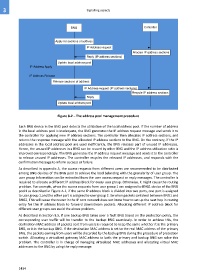Page 1444 - 5G Basics - Core Network Aspects
P. 1444
3 Signalling aspects
BNG Controller
Apply for sections of address
IP Address request
Allocate IP address sections
Reply (IP address sections)
Update local address pool
IP Address Apply
IP Address Release
Release sections of address
IP Address request (IP address sections)
Recycle IP address sections
Reply
Update local address pool
Figure 8-2 – The address pool management procedure
Each BNG device in the BNG pool detects the utilization of the local address pool. If the number of address
in the local address pool is inadequate, the BNG generates the IP address request message and sends it to
the controller for applying new IP address sections. The controller then allocates IP address sections, and
returns the response message with the allocated IP address sections to the BNG. On the contrary, if the IP
addresses in the local address pool are used inefficiently, the BNG releases part of unused IP addresses.
Hence, the unused IP addresses in a BNG can be reused by other BNG and the IP address utilization ratio is
improved correspondingly. The BNG generates the IP address request message and sends it to the controller
to release unused IP addresses. The controller recycles the released IP addresses, and responds with the
confirmation message to inform success or failure.
As described in appendix A, the access requests from different users are recommended to be distributed
among BNG devices of the BNG pool to achieve the load balancing with the granularity of user group. The
user group information can be extracted from the user access request or reply messages. The controller is
required to allocate a different IP address block for every user group. Otherwise, it might cause the routing
problem. For example, when the access requests from user group 1 are assigned to BNG1 device of the BNG
pool1 as described in Figure A-1, if the same IP address block is divided into two parts, one part is assigned
to user group 1,and the other part is assigned to user group 2. So when packets switched between BNG1 and
BNG2, This will cause the router in the IP core network does not know how to set up the next hop in routing
entry for this IP address block to forward downstream packets. Allocating different IP address block for
different user groups can avoid the above problem.
As described in Section 8.5, if one backup BNG takes over a fault BNG based on the protection policy, the
corresponding user traffic will be transfer to the backup BNG seamlessly. In order to achieve this, the
destination MAC address of packets sent from users is required to keep the same whether it is the primary
BNG, or it is the backup BNG. If the destination MAC address is set to the real MAC address of the primary
BNG, the packets coming from users will be discarded by the backup BNG during the procedure of protection
switch. Allocating a virtualized gateway MAC address to both the primary and backup BNG can solve this
problem. The controller is in charge of managing virtualized MAC addresses and allocating virtual MAC
addresses to the BNG by using the reply message.
1434

